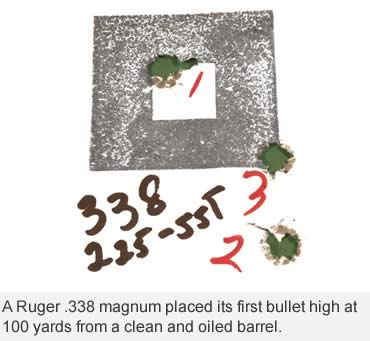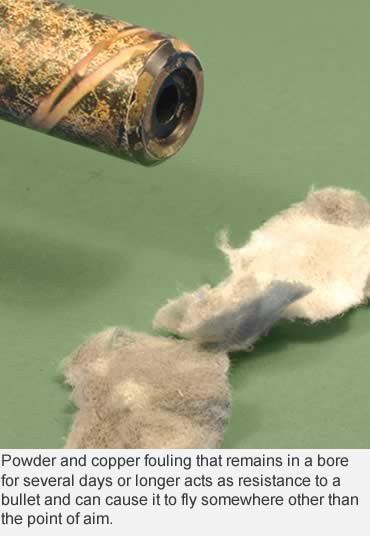All the work that goes into a hunt rides on the first bullet. Make sure it will hit on the mark.
Many hunters go on about how tightly their rifles shoot five-shot groups. Well, the real measure of a hunting rifle is how it shoots a one-shot group. All the money and work that goes into a hunt rides on the first bullet shot from a cold barrel. For that bullet to hit where the crosshairs aim, a rifle’s barrel and receiver must be properly bedded in the stock and its barrel bore clean of even the slightest hindrance to the bullet.
Stock Fit
A friend recently called and said he was about ready to pull out the few remaining hairs on his head because his new rifle would not hold a zero. He explained he would burn up most of a box of ammunition to sight in his bolt-action 7mm magnum. But the next day or week he shot the rifle, it hit far to the right of aim, and he had to sight it in again. This happened several times, and he was running out of both bullets and hair.
I ran out of hair years ago solving that very problem with other rifles. What was happening with his gun was the stock forearm was bearing against the barrel. As he shot the rifle, the barrel heated up and pressed even harder against the stock. That shifted the bullet impact horizontally more and more.
That lateral bullet shift was easily cured by sanding the side of the rifle’s barrel channel enough so a piece of paper, folded in half, easily slipped between the barrel and the stock. After that was done, the rifle put its first and two subsequent shots from a cold barrel right on aim. Two more times the barrel cooled for an hour, and three shots were fired. All nine of those bullets landed on aim and inside 2 inches.
 When a rifle throws its first and subsequent bullets high or low or left or right, it’s often a sign of an improperly bedded receiver. An easy way to determine if that’s the problem is to place a piece of plastic card between the stock and the receiver tang and the stock and the receiver ring. That lifts the receiver so it doesn’t bang around in the stock inletting during firing. That’s the approach I took on a Kimber Model 84M rifle to cure its wandering bullet impact. The permanent treatment was to bed the receiver in the stock with Brownells Acraglas.
When a rifle throws its first and subsequent bullets high or low or left or right, it’s often a sign of an improperly bedded receiver. An easy way to determine if that’s the problem is to place a piece of plastic card between the stock and the receiver tang and the stock and the receiver ring. That lifts the receiver so it doesn’t bang around in the stock inletting during firing. That’s the approach I took on a Kimber Model 84M rifle to cure its wandering bullet impact. The permanent treatment was to bed the receiver in the stock with Brownells Acraglas.
Bore Condition
Many hunters have noted that the first bullet fired from a clean and oiled barrel often hits somewhere other than where they aim. The effect of a clean bore on where my first bullet hit really came to light recently when I shot my 7mm Remington Magnum at 500 yards. From the rifle’s clean and lightly oiled bore, the first bullet hit 10 inches higher than it should have, enough to completely miss a deer.
The reason such a first shot flies high, left or right is the slight blockage that cleaning solvent and oil can leave in a bore. This leads to variations in barrel vibration that cause the first bullet to depart the muzzle when the barrel is at an irregular position.
That obstruction may also cause a bullet to remain in the barrel for a longer-than-normal period, allowing the barrel time to rise in recoil and throw the bullet high. To remedy that problem, many hunters leave a rifle’s bore fouled or fire a fouling shot to blow out the oil before going hunting.
 Fouling that hardens in a bore over time can also impede the bullet. From conducting a long-running shooting test with bunch of rifles, I found the primer and powder residue, left to harden in barrels for a few days to a week, also tended to act as a hindrance to the first bullet.
Fouling that hardens in a bore over time can also impede the bullet. From conducting a long-running shooting test with bunch of rifles, I found the primer and powder residue, left to harden in barrels for a few days to a week, also tended to act as a hindrance to the first bullet.
My Remington Model 700 7mm Rem Magnum is a typical example of a rifle that requires some work to get its first bullet to hit where it should. The first shot from its clean and oiled barrel hit 2 inches high and 1.5 inches to the left of where it had been previously sighted. Two more shots were required to get the rifle shooting where the crosshairs aimed at 100 yards.
I set the rifle aside to cool, and two hours later fired another shot though its fouled and cold barrel. The bullet hit exactly where it was supposed to. After another two-hour wait, I fired another single shot. That bullet also landed exactly on aim.
I left the 7mm’s bore dirty, and a week later, shot the rifle again. The first shot hit 3 inches above aim. The second, third and fourth shots marched 2 inches down the target. Obviously, with any oil or set-up fouling in the bore, it was going to require three or four shots to get the rifle shooting where it should.
The Solution
What if a barrel bore was free of all cleaning solvent, oil and fouling that interfered with that first bullet? To find out, I cleaned the bore of my 7mm magnum, degreased it and dried it. The first shot from the rifle landed right where it was supposed to. Three days later, the bore was again cleaned the same way. The first shot again landed right on aim.
I also tried that cleaning method with a Ruger M77 chambered in .338 Winchester Magnum. The rifle tended to place its first bullet an inch high of where it was sighted with a clean and oiled bore and a fouled bore that had set for a couple weeks. With its bore cleaned and degreased, the .338’s high-impacting first shot disappeared. In fact, the rifle tended to group the first three bullets from its cold barrel often well under an inch at 100 yards, much tighter than it had in the past.
Taking these steps to ensure your rifle puts its first bullet where it should is time well spent. However, every rifle behaves differently, and exactly where that first bullet will land can only be ascertained by shooting. After all, the success of your entire hunt is riding on that first bullet.
This article was published in the August 2008 edition of Buckmasters GunHunter Magazine. Subscribe today to have GunHunter delivered to your home.